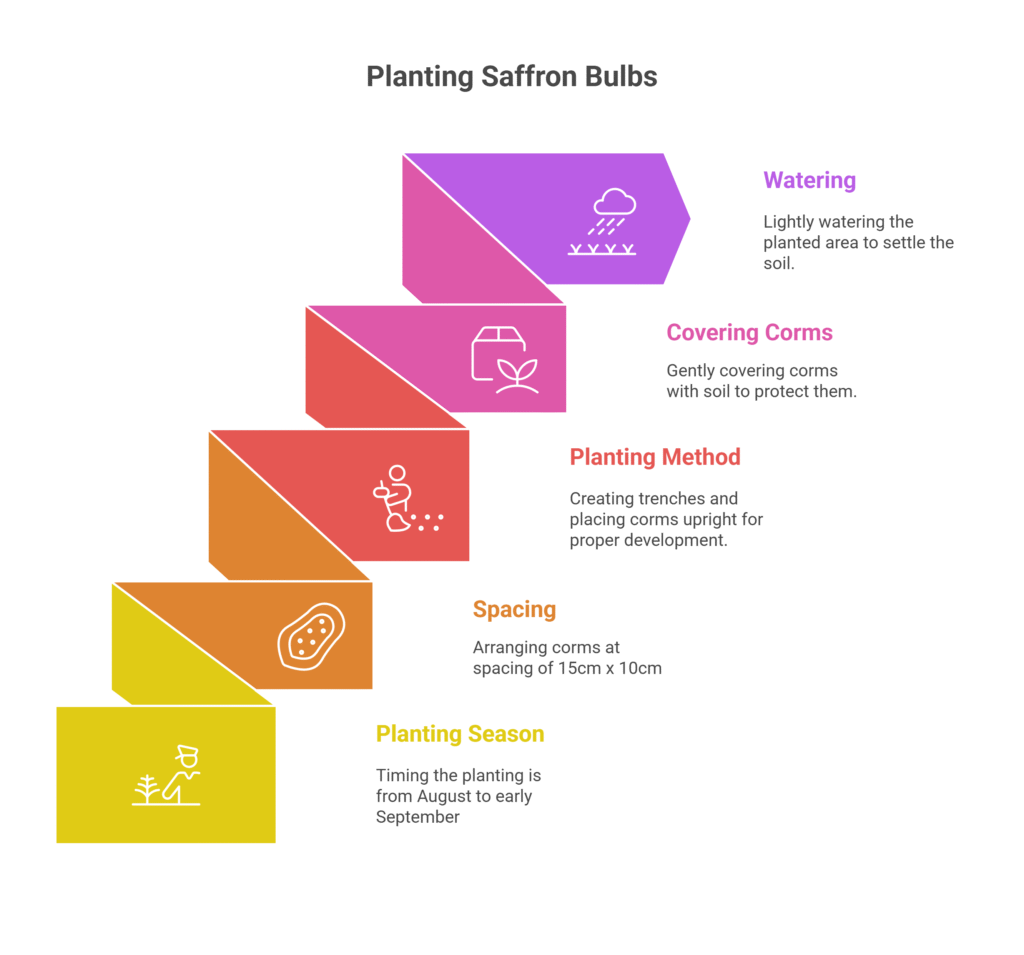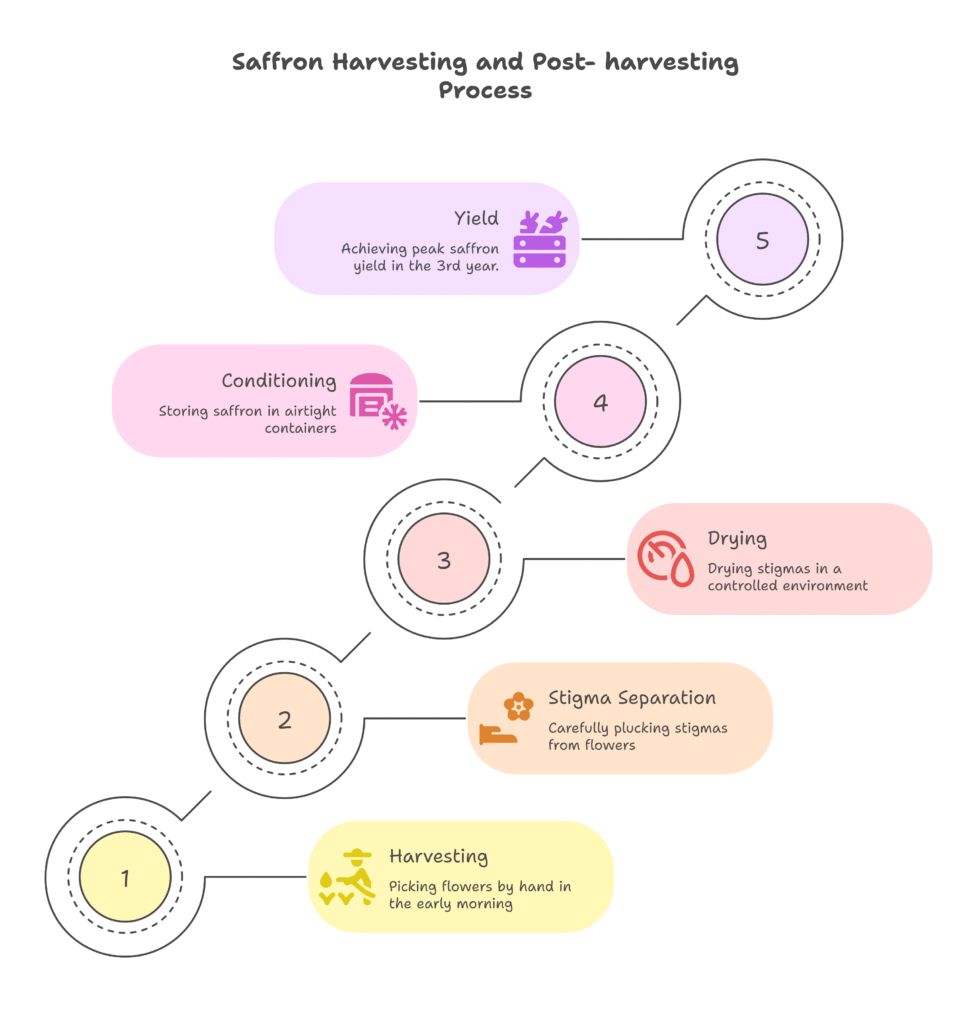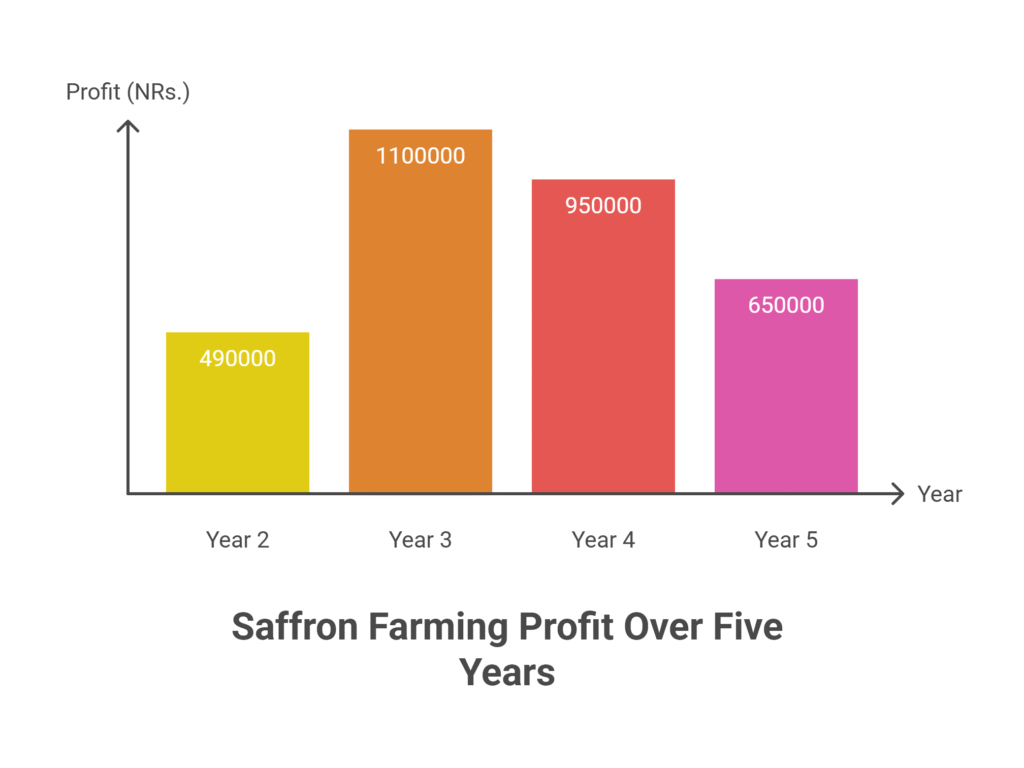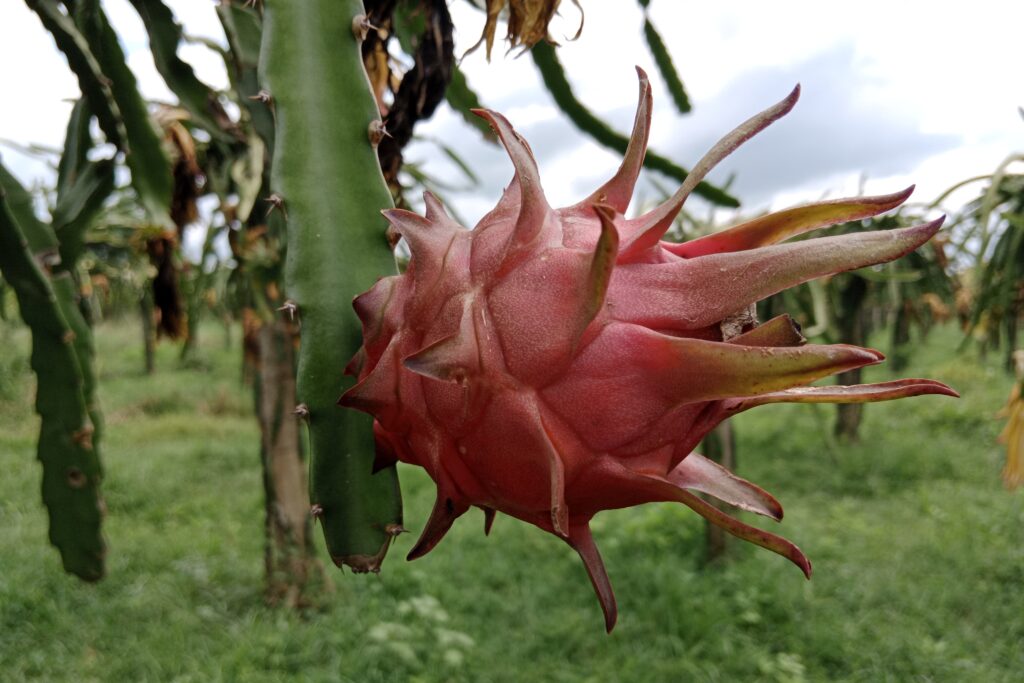Saffron Farming
One of the most valuable and sought-after spices in the world, saffron (Crocus sativus) is valued for its unique scent, vivid color, and therapeutic qualities. It is made from the dried stigmas of the saffron flower and is quite costly to collect because it involves a lot of manual labor. Known as “red gold,” saffron is extremely valuable in the culinary, medicinal, and economic spheres worldwide. Saffron farming profit per acre presents a highly attractive opportunity for long-term returns, as demonstrated by key financial indicators over a five-year cultivation cycle.

With a total investment of NRs. 900,000—covering both initial setup and four years of maintenance—the farming venture yields a total revenue of NRs. 3,990,000 and a net profit of NRs. 3,190,000. This translates to an impressive 80% profit margin and an annualized return on investment (ROI) of 71%. The project achieves break-even by the second year, with cumulative profits reaching NRs. 490,000. The third year marks the peak of profitability, generating NRs. 1,100,000 from a 4 kg saffron yield, while Years 3 and 4 combined contribute 64% of the total net profit, amounting to NRs. 2,050,000.
Land Preparation
Land preparation for saffron farming involves several critical steps to ensure optimal soil conditions. Begin with deep plowing to a depth of 30–40 cm during summer (May–June) to loosen the soil, enhance aeration, and expose harmful soil pests. This is followed by 2–3 rounds of cross harrowing to break clods and achieve a fine tilth, and meticulous leveling of the field.
Raised beds of 15–20 cm height and 1.0–1.5 m width should be formed with properly maintained furrows to facilitate drainage. Soil solarization is highly recommended—cover the beds with clear polythene sheets for 4–6 weeks during peak summer to eliminate soil-borne pathogens, nematodes, and weed seeds. Finally, incorporate 20–25 tonnes of well-decomposed farmyard manure or compost into the top 15–20 cm of soil to enrich it with organic matter.
Soil Type
Saffron thrives best in well-drained, sandy-loam to loamy soils rich in organic matter, with volcanic soils being particularly ideal. While clay loams can be used, they are only suitable if drainage is exceptionally good, as heavy clay or waterlogged conditions must be strictly avoided.
The preferred soil pH ranges from slightly acidic to neutral (6.0–7.5), with an optimal range of 6.3–6.8; the crop can tolerate mildly alkaline soils up to pH 8.0 if they are well-structured and high in organic content. Above all, perfect drainage is a non-negotiable requirement, as saffron corms are highly susceptible to rotting in waterlogged soils, making raised beds essential except in the sandiest conditions.
Climatic Requirements
Saffron cultivation requires specific climatic conditions across different growth stages. During spring, vegetative growth thrives in mild temperatures between 15°C and 25°C, while summer dormancy of corms demands warm and dry conditions ranging from 25°C to 35°C—temperatures above 40°C can cause damage.
Flowering in autumn is triggered by a sharp temperature drop, with optimal conditions being 15°C–20°C during the day and 0°C–10°C at night; light frosts can even enhance yield, though sustained cold below -5°C can harm the flowers. Winter conditions around 0°C–10°C, with some snow or rainfall, benefit corm development, and mulching helps corms withstand brief frosts down to -10°C.
Rainfall should be low to moderate, around 300–500 mm annually, mostly during winter and spring, while dry weather during summer and autumn is essential for both dormancy and flowering phases. Controlled irrigation is important during key growth periods. Low humidity is critical during flowering and harvest to prevent fungal infections on the stigmas.
Saffron requires full sunlight during spring and autumn; while partial shade is tolerated, it can reduce flowering. The crop is best suited for altitudes between 800 and 2,000 meters, where cool autumn nights encourage optimal blooming.
Major Saffron Cultivars
| Origin | Key Cultivars | Characteristics | Market Position |
| Spanish | ‘Superior’ (Coupé), ‘Rio’ | • Lighter red stigmas • Milder flavor • Higher style inclusion • Consistent size grading | Premium (gourmet markets) |
| Kashmiri (India) | ‘Mongra’ (local selections) | • Deepest red color • Strong aroma • Highest crocin content • Exceptional quality | Luxury (highest-priced) |
| Iranian | Khorasan ecotypes | • >90% global production • Deep red color • Varying aroma intensity • High yield | Volume leader (affordable premium) |
| Greek | Krokos Kozanis (PDO) | • Intense red color • Strong aroma & flavor • Protected Designation of Origin | Specialty (EU premium markets) |
| Moroccan | Taliouine | • Strong aroma • Robust flavor profile | Niche (flavor-focused buyers) |
| Italian | L’Aquila | • Distinct flavor profile • Protected origin status | Artisanal (regional Italian marke |
Corm Rate per Acre
For optimal saffron cultivation, corm size plays a critical role in flowering success. Large, healthy corms with a minimum diameter of 2.5 cm—preferably over 3 cm and weighing 8–10 grams—are recommended, as smaller corms (less than 2 cm) often fail to flower in the first year. An acre requires approximately 269,800 corms, and while this high planting density boosts initial yield potential, it also increases the quantity of corms needed and may necessitate earlier lifting and replanting. At an average weight of 8g per corm, the total corm requirement for one acre is roughly 2,158 kg.
Planting
a). Planting Season
The ideal planting season for Crocus sativus (saffron) bulbs is from August to early September, typically 6–8 weeks before the anticipated first frost or autumn rains. This timing is crucial to ensure proper root establishment before the flowering phase begins.

b). Spacing
Plant saffron corms at a depth of 15 to 20 cm, with a 10 cm gap between plants within rows and a 15 cm gap between rows. This planting depth is crucial because it influences flowering and shields the corms from harsh summer heat and winter frost. While deeper planting may cause a minor delay in flowering, it can also increase the corms’ lifetime.
c). Planting Method
The planting method for saffron involves creating trenches or furrows about 15–20 cm deep and placing the corms upright with the pointed bud (plume) facing upward, spaced 10 cm apart within rows and 15 cm between rows.
After planting the first row, the next trench is dug 15 cm beside it, using its soil to cover the previous row, and this sequence is repeated for up to four rows. Corms should be gently covered with soil, ensuring there are no air pockets and avoiding heavy compaction. Light watering is recommended immediately after planting only if the soil is extremely dry, as excess moisture can be harmful.
Intercropping
Although saffron is usually produced as a solo crop because to its unique agronomic requirements, sensitivity to competition, and high economic value, intercropping is often not advised. This is because saffron requires careful management and devoted area for optimal growth and yield.
Irrigation
Irrigation in saffron cultivation must be carefully timed and managed to support critical growth phases such as root establishment after planting, vegetative growth in spring, and pre-flowering in late summer or early autumn if the soil is dry. Drip irrigation is strongly recommended as it conserves water, avoids wetting foliage and flowers, and allows precise moisture control, while furrow irrigation may be used cautiously; overhead sprinklers should never be used.
The irrigation regime includes 1–2 light waterings post-planting (August–September) to settle the soil and promote rooting, and another 1–2 irrigations before flowering in autumn if conditions are dry. No irrigation should be applied during flowering and harvest to prevent rot. In spring (February to May), regular irrigation every 10–15 days supports leaf growth and corm development, but watering must stop as leaves yellow in May or June.
During summer dormancy (June–August), irrigation must be completely avoided. The key principle is to keep the soil dry during dormancy and flowering, and moist during root and leaf development, as overwatering can be fatal to the crop.
Fertilizer and Manure
To promote balanced nutrient management, a soil test result should ideally be used to calculate the proper fertilizer dosage. The following basic fertilizer advice, however, can serve as a guide in the event that such a report is not available.
| Category | Type/Component | Amount per Acre | Timing/Application Method | Notes |
| Organic Matter | Well-rotted FYM/Compost | 15-20 tonnes (initial) 10-15 tonnes (annual) | Initial: Incorporated during land prep Annual: After flowering/lifting or as top dressing in late winter/early spring | Essential foundation |
| Biofertilizer | Azospirillum | 1 kg | It is applied one week after the basal dose application. | |
| PSB (Phosphate Solubilizing Bacteria) | 1 kg | |||
| Potash Mobilizing Bacteria | 1 kg | |||
| Mycorrhiza | 4 kg | |||
| Inorganic (Basal) | Phosphorus (P₂O₅) | 24 kg (e.g., Single Super Phosphate – SSP) | During land prep/before planting | |
| Potassium (K₂O) | 24 kg (e.g., Muriate of Potash) | |||
| Nitrogen (Urea) | 6 kg |
Weed Control
Weeds pose a significant threat, particularly during spring, as they compete vigorously with the crop. Manual weeding is the primary control method and must be done frequently, especially in autumn during flowering and in spring during leaf growth, with extra care around emerging flowers.
Mulching with a 2–5 cm layer of clean straw or dried leaves after flowering in late autumn or early winter helps conserve spring moisture, suppress winter and early spring weeds, and protect corms from frost, but it must be fully removed before the onset of dry summer dormancy.
Chemical weed control should be used with extreme caution—glyphosate (a non-selective herbicide) may be applied during land preparation, while contact herbicides like Paraquat or residual ones like Oxyfluorfen can only be used strictly during the plant’s dormant phase in summer, when no green tissue remains, and never during active growth or flowering.
Flowering and Corm Management
Flowering is triggered by cool autumn temperatures and moisture from rain or pre-flowering irrigation, with bare flowers emerging before leaves over 4-6 weeks; each flower lasts only 2-3 days, and peak flowering occurs over 15-20 days. The corm cycle begins with flowers emerging from the mother corm in autumn.
Following this, leaves grow in spring to photosynthesize and produce food, which is stored in new daughter corms forming atop the mother corm; the leaves then die back in late spring/early summer, the daughter corms enter dormancy during the hot, dry summer, and the mother corm disintegrates.
Essential management includes lifting and replanting every 3-5 years during summer dormancy (May/June): lift corms, clean and grade them (selecting large, healthy corms >2.5-3 cm), treat with fungicide (e.g., Thiram/Captan 0.3%), and replant in August/September in a new location to prevent disease buildup, storing lifted corms in cool, dry, well-ventilated conditions until planting.
Post-flowering care requires protecting emerging leaves from severe frost with light mulch and ensuring adequate spring moisture and nutrients to support leaf growth and corm development.
Pest and Disease Management
Common Pests
a). Rodents (Rats, Voles, Mice)
Rodents (including rats, voles, and mice) pose a major threat as they burrow into the soil and consume corms, particularly during the corms’ dormancy period. Effective control strategies involve the use of traps, the cautious application of rodenticides, and maintaining strict field sanitation practices to minimize habitat and food sources for these pests.
b). Rabbits/Hares
Rodents (including rats, voles, and mice) pose a major threat as they burrow into the soil and consume corms, particularly during the corms’ dormancy period. Effective control strategies involve the use of traps, the cautious application of rodenticides, and maintaining strict field sanitation practices to minimize habitat and food sources for these pests.
c). Thrips/Aphids
Thrips and aphids are minor sap-sucking pests that occasionally infest leaves; they rarely cause significant damage, and control intervention (such as neem oil or a light insecticide spray) is recommended only if infestations become severe.
Common Diseases
a). Corm Rot
Corm rot is the most devastating disease, causing corms to rot in the ground or during storage. Effective control requires perfect drainage, strict crop rotation (minimum 5-7 years), soil solarization, planting only disease-free corms, pre-planting corm treatment with fungicide (Thiram or Captan at 0.3% concentration), avoiding overwatering and physical wounding, and prompt removal and destruction of infected plants and corms.
b). Sclerotium Rot/Violet Root Rot
Corm rot is the most devastating disease, leading to decay of corms both in the ground and during storage; effective control necessitates perfect drainage, strict crop rotation (minimum 5-7 years), soil solarization, exclusive use of disease-free planting material, pre-planting corm treatment with Thiram or Captan fungicide at 0.3% concentration, avoidance of overwatering and physical damage to corms, and the prompt removal and destruction of any infected plants or corms.
c). Leaf Rust
As the most devastating disease causing in-ground and storage decay of corms, effective control requires integrated measures: ensure perfect drainage, implement strict 5–7-year crop rotations, practice soil solarization, plant exclusively disease-free corms, treat corms pre-planting with Thiram or Captan at 0.3% concentration, avoid overwatering and physical injury to corms, and promptly remove/destroy infected plants and corms.
Harvesting
Saffron harvesting is extremely time-sensitive and must occur on the same day the flowers open, ideally during the early morning hours (dawn to 9 AM) before the flowers fully open and their valuable stigmas lose potency or become damaged by sun or wind. Flowering typically begins in mid to late October on the largest Crocus sativus corms, with the harvest window spanning 4-6 weeks. The process is exclusively manual: pickers carefully pluck the entire flower by hand and place them gently into baskets or trays, requiring immense labor due to the delicate nature and short daily picking window.

Post-Harvest Separation (Same Day)
All steps must occur on the same harvest day. First, the three deep red stigmas are carefully hand-plucked from each flower, requiring skilled labor to avoid including excessive yellow style (which lowers quality/grade).
Immediate drying is critical: traditionally, stigmas are spread in thin layers on fine mesh screens in a warm (35°C – 45°C), dark, well-ventilated room for 15-30 minutes, followed by 10-15 minutes at 45°C – 50°C until brittle; alternatively, modern food dehydrators or specialized dryers (max 50°C) offer precise temperature control.
Sun drying is prohibited as it degrades color and flavor. Finally, dried saffron is conditioned in airtight, opaque containers stored in a cool, dark place for 1-2 months to fully develop its aroma before final sale.
Yield
Saffron follows a typical five-year crop cycle, with yields peaking in the third year after planting. On average, an acre of saffron cultivation can produce between 200,000 to 400,000 flowers, resulting in a dried saffron yield ranging from 1.3 kg to 4.0 kg per acre.
Cost of Investment per Acre for Saffron Farming
| S.N. | Category | Cost (NRs) |
| 1 | Land Preparation | 20,000 |
| 2 | Corm Purchase (2200 corms) | 220,000 |
| 3 | Planting | 25,000 |
| 4 | Fertilizers and Manure | 10,000 |
| 5 | Irrigation (Drip) | 75,000 |
| 6 | Mulching | 10,000 |
| 7 | Pest & Disease Control | 7,000 |
| 8 | Harvesting | 15,000 |
| 9 | Post-Harvesting | 8,000 |
| 10 | Miscellaneous Costs | 10,000 |
| Total Initial Investment | 400,000 |
Annual maintenance Cost Per Acre for Saffron Farming
From the second year onward, saffron farming incurs annual maintenance costs that are relatively lower than the initial investment year, as the corms do not need to be replanted annually. The annual maintenance cost is estimated at NRs. 100,000 per acre, which covers essential farming operations such as irrigation, weeding, pest and disease control, fertilization, and labor for flower picking and stigma separation.
This cost also includes periodic expenses for tools maintenance, light mulching, and supervision. Since saffron is a perennial crop with a life cycle of around five years, these annual costs ensure the sustained health and productivity of the plants, especially during the crucial flowering and harvesting periods from Year 2 onwards.
Income from per acre saffron farming
| Year | Yield (kg) | Market Price (NRs/kg) | Income (NRs) |
| 1 | 1.3 | 300,000 | 390,000 |
| 2 | 2.0 | 300,000 | 600,000 |
| 3 | 4.0 | 300,000 | 1,200,000 |
| 4 | 3.5 | 300,000 | 1,050,000 |
| 5 | 2.5 | 300,000 | 750,000 |
| Total | 13.3 | – | 3,990,000 |
Analysis of Saffron Farming Profit Per Acre
| Year | Income (NRs) | Total Cost (NRs) | Annual Profit (NRs) | Cumulative Profit (NRs) |
| 1 | 390,000 | 400,000 (Initial) | -10,000 | -10,000 |
| 2 | 600,000 | 100,000 (Maintenance) | 500,000 | 490,000 |
| 3 | 1,200,000 | 100,000 | 1,100,000 | 1,590,000 |
| 4 | 1,050,000 | 100,000 | 950,000 | 2,540,000 |
| 5 | 750,000 | 100,000 | 650,000 | 3,190,000 |
| Total Cost | Total Profit | 3,190,000 |
The key financial indicators of saffron farming over a five-year period show a total investment of NRs. 900,000 (including initial setup and four years of maintenance), generating total revenue of NRs. 3,990,000 and a net profit of NRs. 3,190,000. This results in a high profit margin of 80% and an impressive annualized ROI of 71%. The investment reaches break-even by the second year with a cumulative profit of NRs. 490,000. Peak profitability occurs in the third year, yielding the highest annual profit of NRs. 1,100,000 from 4 kg of dried saffron. Notably, Years 3 and 4 together account for 64% of the total profit, contributing NRs. 2,050,000 out of the five-year net return.
Crop Calendar for Saffron Farming (Northern Hemisphere)
| Month | Growth Stage | Key Activities | Agronomic Notes |
| May–June | Summer Dormancy | · Land Prep: Deep plow (30–40 cm), harrow 2–3x, level soil. · Soil Solarization: Cover beds with clear polythene for 4–6 weeks. · FYM Incorp: 15–20 tonnes/acre well-rotted manure mixed into topsoil. · Corm Lifting (every 3–5 yrs): Dig, clean, grade (>2.5–3 cm), treat with Thiram/Captan (0.3%), store in cool/dry conditions. | ♦ Irrigation: Strictly prohibited. ♦ Weed Control: Apply glyphosate/Oxyfluorfen only during dormancy. |
| July | Dormancy | · Storage Check: Monitor lifted corms for rot/rodents. · Field Sanitation: Remove plant debris, maintain rodent traps. | ♦ Soil must be dry; no field activity beyond maintenance. |
| August | Pre-Planting | · Planting: Set corms (2,158 kg/acre) 15–20 cm deep, pointed bud up, 10 cm in-row × 15 cm between rows. · Basal Fertilizers: Apply 24kg P₂O₅ (SSP) + 24kg K₂O (MOP) + 6kg N (Urea) + biofertilizers (Azospirillum/PSB/Mycorrhiza). · Light Irrigation: 1–2 rounds if soil is dry. | ♦ Use drip irrigation only; avoid waterlogging. |
| September | Root Establishment | · Pre-Flowering Irrigation: 1–2 sessions if autumn rains fail. · Mulch Prep: Source clean straw/dried leaves. | ♦ No irrigation once flowering starts. |
| October | Flowering | · Harvest: Daily picking (dawn–9 AM) of freshly opened flowers. · Post-Harvest: Same-day stigma separation; dry at 35–50°C (no sun drying). | ♦ Peak harvest: 15–20 days mid-month; 4–6 week window. ♦ Yield: 200k–400k flowers/acre (1.3–4 kg dried saffron). |
| November | Post-Flowering | · Annual FYM: Apply 10–15 tonnes/acre as top dressing. · Frost Protection: Light mulch (2–5 cm) over emerging leaves. · Conditioning: Store dried saffron in airtight dark containers. | ♦ Mulch conserves moisture; remove before summer. |
| Dec–Jan | Winter Dormancy | · Rodent Control: Deploy traps/rodenticides near corm beds. · Frost Monitoring: Ensure mulch coverage. | ♦ Soil temp: 0–10°C; brief frosts (< -5°C) tolerated with mulch. |
| February | Leaf Emergence | · Top Dressing 1: Apply 6kg N (Urea). · Irrigation: Resume drip every 10–15 days. · Weeding: Manual removal. | ♦ Temp: 15–25°C; supports vegetative growth. |
| March | Leaf Growth | · Pest Control: Spray neem oil (if thrips/aphids severe). · Irrigation: Maintain soil moisture. | ♦ Monitor for leaf rust; remove infected plants. |
| April | Corm Development | · Top Dressing 2: Apply 6kg N (Urea). · Weed Control: Manual weeding during peak growth. | ♦ Critical phase: Photosynthesis fuels daughter corm growth. |
| Year-Round | General | · Disease Mgmt: Ensure drainage; rotate crops every 5–7 yrs; avoid wounding corms. · Economics: Break-even in Year 2; peak profit (₹1.1M) in Year 3. | ♦ Avg ROI: 71% |
Sources
North American Center for Saffron Research & Development
Shrestha, Sailesh & Pathak, Rukmagat. (2024). Saffron Production Technology in Nepal. Malaysian Journal of Halal Research. 7. 33-37.
Nehvi, F. A., & Yasmin, S. (2015). Enhancing Saffron Production in Jammu and Kashmir. Indian Farming, 64(2).
Sativus.com




Hello everyone,
I am christophe AYABAGABO, an agronomist by professional. I heard about saffron crops recently from my friend and i am very interested in working on Saffron value chain. If possible you can share with me this farming manual on the following email: ayabochrist@gmail.com
Any additional information or linkages to others institutions, farmers pr companies dealing with saffron value chain will be much appreciated. I wish to introduce it in East Africa especially starting from Rwanda, Kigali.
Best regards,
Contact and WhatsApp number is:+250788471619
Christophe.